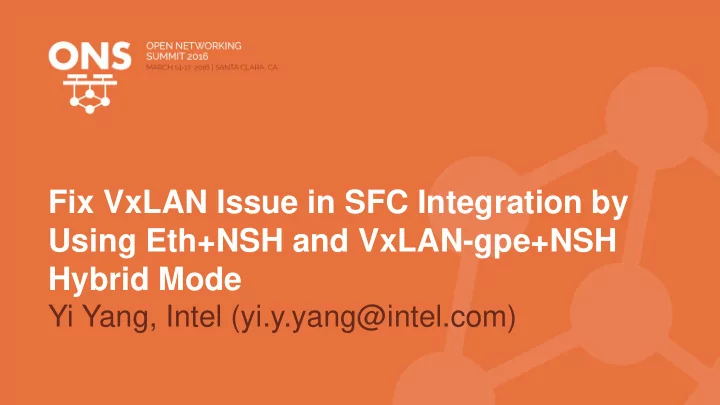

Fix VxLAN Issue in SFC Integration by Using Eth+NSH and VxLAN-gpe+NSH Hybrid Mode Yi Yang, Intel (yi.y.yang@intel.com)
Agenda • VxLAN Issue in OVSDB+SFC • How to Fix Current VxLAN issue by Eth+NSH • Demo Introduction • Demo • Next Steps
VxLAN Issue in OVSDB + SFC + Openstack + Tacker • The traffic to a SF(Service Function) has to be encapsulated by VxLAN-gpe with NSH header • What will happen • Classifier sets tunnel ID (VNID), NSI (Network Service Index), NSP (Network Service Path) , tunnel destination IP • Output the packet to the VxLAN-gpe port • At this point, Linux kernel (vport_vxlan.ko) gets the control • vport_vxlan will query how to route this packet • If tunnel destination IP is set to 192.168.50.75, it will be routed to host2 • If tunnel destination IP is set to 10.0.35.3, it will be dropped because the route table in host1 doesn’t have an entry for that. • The result: the packet with VxLAN- gpe + NSH header can’t be routed to the SF
Host1 Host2 VM1 SF1 VM2 SF2 10.0.35.2 10.0.35.3 10.0.36.4 10.0.36.5 eth0 eth0 eth1 eth1 tap1 tap2 tap1 tap2 vxlan1 vxlan1 vxlan-gpe1 vxlan-gpe1 br-int br-int drop eth1 eth1 192.168.50.70 192.168.50.75
VxLAN Issue in OVSDB+SFC table=0,icmp,nw_dst=10.0.36.4 actions=set_nsi:255,set_nsp:0x13,set_nshc1:0xc0a83246,set_nshc2:0x9,set_nshc3:0x12345678, set_nshc4:0x98765432,load:0xc0a8324b->NXM_NX_TUN_IPV4_DST[],load:0x9->NXM_NX_TUN_ID[0..31],output:6 192.168.50.75 table=0,icmp,nw_dst=10.0.36.4 actions=set_nsi:255,set_nsp:0x13,set_nshc1:0xc0a83246,set_nshc2:0x9,set_nshc3:0x12345678, set_nshc4:0x98765432,load:0x0a002303->NXM_NX_TUN_IPV4_DST[],load:0x9->NXM_NX_TUN_ID[0..31],output:6 10.0.35.3 Note: port 6 is port vxlan-gpe1
How to Fix Current VxLAN issue by Eth + NSH • Use Eth + NSH instead of VxLAN-gpe + NSH for communication between VMs on the same compute node/ovs bridge • Use VxLAN-gpe + NSH only for communication between VMs on different compute nodes/ovs bridges • Need to change ovs, openflowplugin, sfc, ovsdb, gbp to support this • Intel owned ovs nsh support and changed ovs to support push&pop nshð actions, but they are not committed into ovs git tree, Redhat and Intel are committed to submiting related changes into Linux kernel net subtree and ovs git tree • Openflowplugin changes: https://git.opendaylight.org/gerrit/#/c/30481/ • Change sfcofl2 (sfc openflow renderer) and sfc classifier • TBD for ovsdb and gbp
Host1 Host2 VM1 SF1 VM2 SF2 10.0.35.2 10.0.35.3 10.0.36.4 10.0.36.5 Eth+NSH eth0 eth0 eth1 eth1 Eth+NSH tap1 tap2 tap1 tap2 vxlan1 vxlan1 vxlan-gpe1 vxlan-gpe1 br-int br-int VxLAN-gpe+NSH eth1 eth1 192.168.50.70 192.168.50.75
Demo Introduction • Host1 and Host2 are vagrant boxes (VirtualBox images, Ubuntu Trusty x86_64) • VM1, VM2, SF1 And SF2 are docker containers (Ubuntu Trusty x86_64) • SF1 and SF2: python3 ./vxlan-tool.py --do=forward -i eth0 • https://git.opendaylight.org/gerrit/gitweb?p=sfc.git;a=blob_plain;f=sfc-test/nsh- tools/vxlan_tool.py;h=3b05aff03aa60c556a836efc471f65d1c2595b97;hb=HEAD • Demo two traffics • ICMP: ping VM2 from VM1, it will go through VM1->SF1->SF2->VM2 • HTTP: wget http://10.0.36.4/ in VM1, it will also go through VM1->SF1->SF2->VM2 https://www.youtube.com/watch?v=3SlqKxZp9nY
1 SFC Classifier (table 0) pushes NSH header, sfcofl2 (table 4) pushes Eth header (Destination MAC is SF1’s) 2 sfcofl2 (table 10) pops Eth header and sets VNID and tunnel destination IP (192.168.50.75) 3 sfcofl2 (table 4 ) pushes Eth header (Destination MAC is SF2’s) sfcofl2 (table 10) pops Eth and NSH header 4 Host1 Host2 VM1 SF1 VM2 SF2 10.0.35.2 10.0.35.3 10.0.36.4 10.0.36.5 eth0 eth0 eth1 eth1 Eth+NSH Eth+NSH Eth+NSH tap1 tap2 tap1 tap2 Eth+NSH 1 Original 2 4 3 Original Frame vxlan1 vxlan-gpe1 vxlan1 Frame vxlan-gpe1 br-int br-int VxLAN-gpe+NSH VxLAN-gpe+NSH eth1 eth1 192.168.50.70 192.168.50.75
Next Steps • Commit our ovs nsh code to ovs git tree • Push our changes in Openflowplugin (push_eth, push_nsh, pop_eth, pop_nsh) to Boron release • Push sfc classifier and sfcofl2 changes into Boron release • Set up the same demo in OVSDB+SFC+Openstack+Tacker integration (depends on if it is ready for such network topology) • Push Openflowplugin Flow Programmer (A solution to openflow multi-writer issue/App coexistence issue) to Boron release • Integrate Openflowplugin Flow Programmer to SFC, OVSDB and GBP
original frame VM1 push_nsh classifier sfcofl2 push_eth Outer Eth, ET=0x894F, DST=SF1 NSH, NP=0x3, NSI=255 original frame SF1 IN SF1 OUT Outer Eth, ET=0x894F, DST=DEF NSH, NP=0x3, NSI=254 original frame sfcofl2 pop_eth NSH, NP=0x3, NSI=254 original frame sfcofl2 Eth, ET=0x0800 IP, UDP, DTP=4790 VXLAN-gpe, NP=0x4 NSH, NP=0x3, NSI=254 original frame Host1 IP, UDP, DTP=4790 VXLAN-gpe, NP=0x4 Eth, ET=0x0800 NSH, NP=0x3, NSI=254 original frame Host2 ET: Ethernet Type NSH, NP=0x3, NSI=254 original frame sfcofl2 DST: Destination MAC push_eth sfcofl2 DTP: Destination Transmission Layer/L4 port NP: Next Protocol Outer Eth, ET=0x894F, DST=SF2 NSH, NP=0x3, NSI=254 original frame SF2 IN NSI: Network Service Index openflow action original packet Outer Eth, ET=0x894F, DST=DEF NSH, NP=0x3, NSI=253 original frame SF2 OUT NSH header VxLAN-gpe header pop_eth;push_nsh sfcofl2 Eth header original frame VM2 IP+UDP header
Classifier flow entries: Host1 ARP response: (ping: step 1) table=0, priority=1000,arp,arp_tpa=10.0.35.1,arp_op=1 actions=move:NXM_OF_ETH_SRC[]->NXM_OF_ETH_DST[], set_field:88:f0:31:b5:12:b5->eth_src,load:0x2->NXM_OF_ARP_OP[],move:NXM_NX_ARP_SHA[]->NXM_NX_ARP_THA[], load:0x88f031b512b5->NXM_NX_ARP_SHA[],move:NXM_OF_ARP_SPA[]->NXM_OF_ARP_TPA[],load:0xa002301->NXM_OF_ARP_SPA[], IN_PORT Routing: (ping: step 31, the second packet and later) table=0, priority=1000,ip,dl_dst=88:f0:31:b5:12:b5,nw_dst=10.0.35.2 actions=set_field:88:f0:31:b5:12:b5->eth_src, set_field:00:00:00:00:35:02->eth_dst,dec_ttl,output:2 Make sure the packets from VxLAN-gpe port and the packets with Eth+NSH header can go through sfcofl2 pipeline: table=0, priority=1001,in_port=6 actions=load:0x9->NXM_NX_REG0[],goto_table:1 (ping: step 23) table=0, priority=1001,encap_eth_type=20361 actions=goto_table:1 (ping: step 27) Classifier ACL for ICMP: (ping: step 2) table=0, priority=1000,icmp,in_port=2,nw_src=10.0.35.2,nw_dst=10.0.36.4 actions=load:0x64->NXM_NX_TUN_ID[],push_nsh, load:0x1->NXM_NX_NSH_MDTYPE[],load:0x3->NXM_NX_NSH_NP[],load:0x4->NXM_NX_NSP[0..23],load:0xff->NXM_NX_NSI[], load:0x1->NXM_NX_NSH_C1[],load:0x64->NXM_NX_NSH_C2[],load:0x3->NXM_NX_NSH_C3[],load:0x4->NXM_NX_NSH_C4[], goto_table:4 Classifier ACL for TCP: table=0, priority=1000,tcp,in_port=2,nw_src=10.0.35.2,nw_dst=10.0.36.4,tp_dst=80 actions=load:0x65->NXM_NX_TUN_ID[], push_nsh,load:0x1->NXM_NX_NSH_MDTYPE[],load:0x3->NXM_NX_NSH_NP[],load:0x4->NXM_NX_NSP[0..23],load:0xff->NXM_NX_NSI[], load:0x1->NXM_NX_NSH_C1[],load:0x65->NXM_NX_NSH_C2[],load:0x3->NXM_NX_NSH_C3[],load:0x4->NXM_NX_NSH_C4[], goto_table:4
Classifier flow entries: Host1 This flow entry is to make sure the packet returned back by VM2 can be delivered into VM1: (ping: step 31, the first packet) table=0, priority=999,nsh_mdtype=0,encap_eth_type=0 actions=set_field:88:f0:31:b5:12:b5->eth_src,set_field:00:00:00:00:35:02->eth_dst, output:2 Sfcofl2 flow entries: table=0, priority=5 actions=goto_table:1 Make sure the packets from VxLAN-gpe port and the packets with Eth+NSH header can go through sfcofl2 pipeline: table=1, priority=252,reg0=0x9 actions=goto_table:4 (ping: step 24) table=1, priority=251,encap_eth_type=20361 actions=goto_table:4 (ping: step 28) table=1, priority=250,ip actions=goto_table:4 table=1, priority=5 actions=drop table=2, priority=5 actions=goto_table:3 table=3, priority=5 actions=goto_table:4 push_eth for the packets from VM1, for SF1 input: (ping: step 3) table=4, priority=550,nsi=255,nsp=4 actions=push_eth,load:0x894f->NXM_NX_ENCAP_ETH_TYPE[], load:0x88f031b512b5->NXM_NX_ENCAP_ETH_SRC[],load:0x3503->NXM_NX_ENCAP_ETH_DST[],goto_table:10 Set tunnel ID and tunnel destination IP for SF1 output: table=4, priority=550,nsi=254,nsp=4 actions=move:NXM_NX_NSH_C2[]->NXM_NX_TUN_ID[0..31],load:0xc0a8324b- >NXM_NX_TUN_IPV4_DST[], goto_table:10
Recommend
More recommend